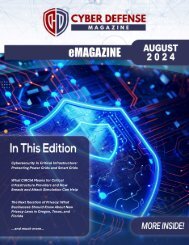Cyber Defense eMagazine June 2020 Edition
Cyber Defense eMagazine June Edition for 2020 #CDM #CYBERDEFENSEMAG @CyberDefenseMag by @Miliefsky a world-renowned cyber security expert and the Publisher of Cyber Defense Magazine as part of the Cyber Defense Media Group as well as Yan Ross, US Editor-in-Chief, Pieruligi Paganini, Co-founder & International Editor-in-Chief, Stevin Miliefsky, President and many more writers, partners and supporters who make this an awesome publication! Thank you all and to our readers! OSINT ROCKS! #CDM #CDMG #OSINT #CYBERSECURITY #INFOSEC #BEST #PRACTICES #TIPS #TECHNIQUES
Cyber Defense eMagazine June Edition for 2020 #CDM #CYBERDEFENSEMAG @CyberDefenseMag by @Miliefsky a world-renowned cyber security expert and the Publisher of Cyber Defense Magazine as part of the Cyber Defense Media Group as well as Yan Ross, US Editor-in-Chief, Pieruligi Paganini, Co-founder & International Editor-in-Chief, Stevin Miliefsky, President and many more writers, partners and supporters who make this an awesome publication! Thank you all and to our readers! OSINT ROCKS! #CDM #CDMG #OSINT #CYBERSECURITY #INFOSEC #BEST #PRACTICES #TIPS #TECHNIQUES
You also want an ePaper? Increase the reach of your titles
YUMPU automatically turns print PDFs into web optimized ePapers that Google loves.
executables, teens are known to visit risky sites, and many family members don’t understand the risks of<br />
spam, unable to spot the difference between real and fake apps and emails.<br />
Each of these devices represents an entry point for attackers, and threat actors know this. They<br />
understand that WFH employees are unprotected by centralized enterprise security stacks. Once a bad<br />
actor has gained access to an edge device on the home network, they can go undetected, moving<br />
laterally across the network to the end goal: the company’s corporate devices and data.<br />
With the millions of additional points of remote access now in use, threat actors will be scanning more<br />
often, leading to more brute force attacks and more lateral movement. Security teams quickly need to<br />
find an alternative method for securing WFH Wi-Fi connections.<br />
Shoring Up Home <strong>Defense</strong>s:<br />
Work from Home (WFH) is a viable alternative for many companies, but unfortunately, IT teams weren’t<br />
ready for the inherent risks and implications that home Wi-Fi networks pose.<br />
Organizations have no visibility or control over these home Wi-Fi networks, and therefore cannot trust<br />
them.<br />
Home Wi-Fi hygiene can be improved by regularly changing passwords for Wi-Fi networks, changing the<br />
default router password, creating a guest network, and keeping router's firmware up to date. However,<br />
even with those steps, risks persist for organizations with WFH employees because enforcement is<br />
impossible, meaning the organization will never achieve full compliance. These steps also don’t solve<br />
the gap in protection left by VPNs<br />
Organizations need to find an easier, enforceable way for securing WFH employees.<br />
Extending Zero Trust Access to Any Remote Wi-Fi Connection<br />
The assumption that all networks are dirty is fundamental to any effective remote work security strategy<br />
such as Zero Trust. The best way to ensure that a home worker doesn’t corrupt the corporate network or<br />
otherwise expose key assets is to isolate their devices from their untrusted home Wi-Fi networks. In<br />
essence, this means micro-segmenting the remote device and creating a network of one. This step<br />
extends Zero Trust access to any remote Wi-Fi network connection.<br />
The Center for Internet Security's Wireless Access Controls recommends users “Create a separate<br />
wireless network for personal or untrusted devices. Enterprise access from this network should be treated<br />
as untrusted and filtered and audited accordingly.”<br />
That’s what endpoint micro-segmentation achieves: the employee’s device is physically isolated from the<br />
rest of the home Wi-Fi network, with plug and play USB hardware that delivers a “micro-segment of one.”<br />
This approach protects the individual’s device and the organization’s network from the various home Wi-<br />
Fi borne threats that security software doesn’t address.<br />
<strong>Cyber</strong> <strong>Defense</strong> <strong>eMagazine</strong> –<strong>June</strong> <strong>2020</strong> <strong>Edition</strong> 59<br />
Copyright © <strong>2020</strong>, <strong>Cyber</strong> <strong>Defense</strong> Magazine. All rights reserved worldwide.


















